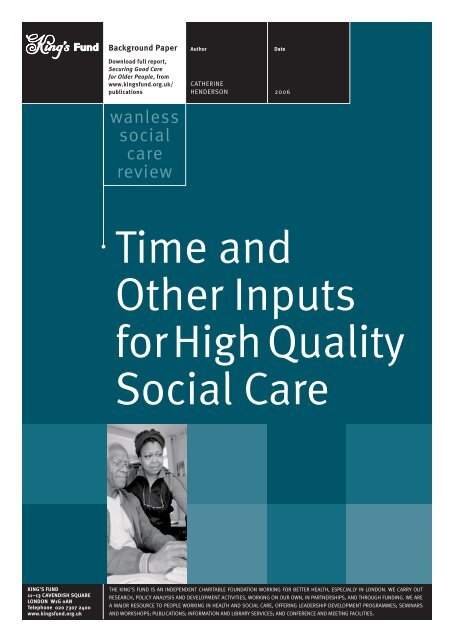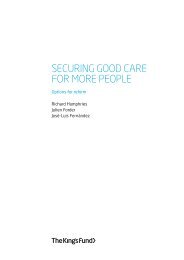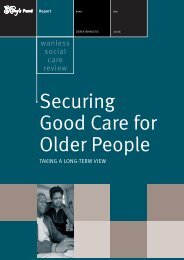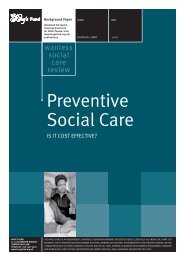Time and other inputs for high quality social care - The King's Fund
Time and other inputs for high quality social care - The King's Fund
Time and other inputs for high quality social care - The King's Fund
You also want an ePaper? Increase the reach of your titles
YUMPU automatically turns print PDFs into web optimized ePapers that Google loves.
Background Paper<br />
Author<br />
Date<br />
Download full report,<br />
Securing Good Care<br />
<strong>for</strong> Older People, from<br />
www.kingsfund.org.uk/<br />
publications<br />
CATHERINE<br />
HENDERSON 2006<br />
wanless<br />
<strong>social</strong><br />
<strong>care</strong><br />
review<br />
<strong>Time</strong> <strong>and</strong><br />
Other Inputs<br />
<strong>for</strong> High Quality<br />
Social Care<br />
KING’S FUND<br />
11–13 CAVENDISH SQUARE<br />
LONDON W1G 0AN<br />
Telephone 020 7307 2400<br />
www.kingsfund.org.uk<br />
THE KING’S FUND IS AN INDEPENDENT CHARITABLE FOUNDATION WORKING FOR BETTER HEALTH, ESPECIALLY IN LONDON. WE CARRY OUT<br />
RESEARCH, POLICY ANALYSIS AND DEVELOPMENT ACTIVITIES, WORKING ON OUR OWN, IN PARTNERSHIPS, AND THROUGH FUNDING. WE ARE<br />
A MAJOR RESOURCE TO PEOPLE WORKING IN HEALTH AND SOCIAL CARE, OFFERING LEADERSHIP DEVELOPMENT PROGRAMMES; SEMINARS<br />
AND WORKSHOPS; PUBLICATIONS; INFORMATION AND LIBRARY SERVICES; AND CONFERENCE AND MEETING FACILITIES.
wanless<br />
<strong>social</strong><br />
<strong>care</strong><br />
review<br />
TIME AND OTHER INPUTS FOR<br />
HIGH QUALITY SOCIAL CARE<br />
Catherine Henderson
This is one of a series of appendices to Securing Good Care <strong>for</strong> Older People. Download full report<br />
from www.kingsfund.org.uk/publications<br />
© King’s <strong>Fund</strong> 2006<br />
First published 2006 by the King’s <strong>Fund</strong>.<br />
Charity registration number: 207401<br />
All rights reserved, including the right of reproduction in whole or in part in any <strong>for</strong>m.<br />
www.kingsfund.org.uk/publications<br />
Typeset by Andrew Haig <strong>and</strong> Associates<br />
Front cover image by Sara Hannant www.sarahannant.com
Contents<br />
Background <strong>and</strong> context of literature review 1<br />
Issues with measuring ‘good <strong>quality</strong> <strong>social</strong> <strong>care</strong>’ 1<br />
Relationship of time <strong>inputs</strong> to <strong>quality</strong> of bed-based <strong>care</strong> 2<br />
Methods of the literature review 3<br />
Search strategy 3<br />
Evidence from the review 5<br />
Home-based <strong>care</strong> <strong>and</strong> <strong>quality</strong> 5<br />
Adequacy <strong>and</strong> sufficiency of home-based <strong>care</strong> 6<br />
User experiences, satisfaction <strong>and</strong> person-centred <strong>care</strong> 7<br />
Preferences <strong>for</strong> <strong>quality</strong> in home-based <strong>care</strong> <strong>for</strong> people with dementia 9<br />
Summary 10<br />
Inputs <strong>for</strong> ‘<strong>quality</strong>’ home-based <strong>social</strong> <strong>care</strong> 11<br />
Notes 21<br />
Annexe 22<br />
Databases searched 22<br />
Search terms 22<br />
References 24<br />
Literature search 24<br />
Further references 26
Background <strong>and</strong> context<br />
of literature review<br />
This paper reports the results of a brief review of the literature on the time <strong>and</strong> <strong>other</strong><br />
service <strong>inputs</strong> required to provide ‘<strong>high</strong> <strong>quality</strong>’ or ‘best practice’ <strong>social</strong> <strong>care</strong> to frail older<br />
people, with <strong>and</strong> without cognitive impairment. It uses this in<strong>for</strong>mation to produce two<br />
tables. <strong>The</strong> first table (Table 1, see pp 13–16) provides descriptions of service users with<br />
various levels of physical dependency <strong>and</strong> cognitive impairment. <strong>The</strong> second table<br />
(Table 2, see pp 17–20) lists the corresponding number <strong>and</strong> duration of <strong>social</strong> <strong>care</strong> tasks<br />
that might be received in a typical day by people within each category.<br />
Issues with measuring ‘good <strong>quality</strong> <strong>social</strong> <strong>care</strong>’<br />
<strong>The</strong>re are a number of issues to bear in mind when measuring the <strong>quality</strong> of <strong>social</strong> <strong>care</strong>.<br />
<strong>The</strong> first is the question of how ‘<strong>quality</strong>’ is defined. In his 2002 book, Moullin lists several<br />
approaches to defining <strong>quality</strong>:<br />
• transcendent – the degree of excellence or superiority<br />
• product-based – dependent on aspects of product <strong>and</strong> usually one-dimensional<br />
• manufacturing-based – con<strong>for</strong>mance to specification<br />
• consumer-based – meeting or exceeding the customer’s requirements<br />
• value-based – the trade-off between af<strong>for</strong>dability <strong>and</strong> excellence, that is, the balance<br />
between cost <strong>and</strong> value to the consumer.<br />
<strong>The</strong> second issue to consider is, who should be the judge of the <strong>quality</strong> of <strong>social</strong> <strong>care</strong>? <strong>The</strong><br />
literature reports both <strong>care</strong>givers’ <strong>and</strong> professionals’ perspectives on <strong>quality</strong>. When<br />
considering the different perspectives, it is important to note that those with dementia,<br />
their <strong>care</strong>givers, <strong>and</strong> the professionals assessing them may have different perceptions of<br />
the functional levels of the user (Zank <strong>and</strong> Frank 2002) <strong>and</strong> the <strong>quality</strong> of home <strong>care</strong><br />
(Larsson <strong>and</strong> Wilde Larsson 1998); similarly, older people with physical impairments may<br />
report <strong>high</strong>er functional levels <strong>and</strong> lower needs <strong>for</strong> assistance than the professionals who<br />
are assessing them (Morrow-Howell et al 2001). Any data collected on <strong>quality</strong> there<strong>for</strong>e<br />
varies according to the particular sample of respondents. <strong>The</strong>se measurement issues may<br />
affect policy-makers’ judgements on the amount of time that should be spent on <strong>social</strong><br />
<strong>care</strong>.<br />
<strong>The</strong> third issue to consider when measuring the <strong>quality</strong> of <strong>social</strong> <strong>care</strong> is that the amount of<br />
time taken to provide <strong>social</strong> <strong>care</strong> depends to some degree on geographical location. Where<br />
<strong>care</strong>rs, whether <strong>for</strong>mal or in<strong>for</strong>mal, have to travel greater distances to reach the person<br />
requiring assistance <strong>and</strong> carry out instrumental tasks such as shopping (Innes et al 2005),<br />
this may contribute to a poorer <strong>quality</strong> experience of <strong>for</strong>mal <strong>care</strong> in terms of reliability <strong>and</strong><br />
continuity (Netten et al 2004). <strong>The</strong> fourth issue to bear in mind is that those with the most<br />
intensive service use may report the least satisfaction with <strong>for</strong>mal services (Netten et al<br />
2004) <strong>and</strong> indeed may be seen as having more unmet needs by professional assessors<br />
(Morrow-Howell et al 2001).<br />
BACKGROUND AND CONTEXT OF LITERATURE REVIEW 1
Relationship of time <strong>inputs</strong> to <strong>quality</strong> of bed-based <strong>care</strong><br />
<strong>The</strong>re is a whole body of literature exploring the relationship between <strong>quality</strong> <strong>and</strong> time<br />
spent on <strong>care</strong> tasks in nursing homes. Particularly important are the outputs of a US<br />
programme of research into the appropriateness of minimum nurse staffing ratios in<br />
nursing homes. <strong>The</strong>re were two phases of research culminating in reports to the US<br />
Congress, the first in 2000 (Centers <strong>for</strong> Medi<strong>care</strong> <strong>and</strong> Medicaid Services 2000) <strong>and</strong> the<br />
second in 2001 (Centers <strong>for</strong> Medi<strong>care</strong> <strong>and</strong> Medicaid Services 2001). As part of the<br />
research, one of the teams created a model to establish the ‘staffing levels necessary to<br />
achieve “good” nursing facility <strong>care</strong>’ (Centers <strong>for</strong> Medi<strong>care</strong> <strong>and</strong> Medicaid Services 2000,<br />
p 3-1). For the first report, the researchers used the model to examine the staffing levels<br />
necessary to allow the implementation of five <strong>care</strong> processes:<br />
• assisting incontinent residents who are able to toilet successfully with help<br />
• changing wet linen <strong>for</strong> incontinent residents who are unable to toilet successfully, even<br />
with help<br />
• helping physically dependent residents <strong>and</strong> those with a low food intake to eat<br />
• providing (physical) exercises to all residents<br />
• providing help that enhances the residents ability to dress <strong>and</strong> groom independently.<br />
<strong>The</strong> second report describes a further stage of modelling, which aimed to extend <strong>and</strong><br />
improve the estimates of minimum staff required to implement these five processes. <strong>The</strong><br />
results of the model indicated that 2.8 to 3.2 nursing aide hours per resident per day<br />
would be required to consistently provide all the daily <strong>care</strong> processes; however, this time<br />
estimate also included tasks that were not directly related to individual residents (<strong>for</strong><br />
example, note-writing <strong>and</strong> so on). A further study by the same research team found that<br />
nursing homes with the <strong>high</strong>est staffing levels provided better <strong>care</strong>, measured in terms of<br />
the implementation of 16 <strong>care</strong> process measures, than homes with lower staffing levels<br />
(Schnelle et al 2004).<br />
Although this literature search was not focused on institutional <strong>care</strong> (<strong>and</strong> it would have<br />
been difficult to apply the findings of these reports directly to the amount of <strong>care</strong> provided<br />
to an individual living at home), the estimate produced by the Centers <strong>for</strong> Medi<strong>care</strong> <strong>and</strong><br />
Medicaid Services is potentially very useful. It provides a guideline <strong>for</strong> aide/assistant time<br />
needed to provide <strong>quality</strong> personal <strong>care</strong> <strong>for</strong> those with relatively <strong>high</strong> physical<br />
dependency. By contrast, the author could find no papers that addressed the relationship<br />
between time <strong>inputs</strong> <strong>and</strong> the <strong>quality</strong> of community or home-based <strong>care</strong> quite so explicitly.<br />
2 TIME AND OTHER INPUTS FOR HIGH QUALITY SOCIAL CARE
Methods of the literature review<br />
When conducting the literature review, the initial question posed by the author was ‘what<br />
amounts of time <strong>and</strong> <strong>other</strong> service <strong>inputs</strong> are required to provide “<strong>high</strong> <strong>quality</strong>” or “best<br />
practice” <strong>social</strong> <strong>care</strong> to frail older people, with or without cognitive impairment?’ However,<br />
after further consultation with the commissioners of the paper, the author refocused the<br />
search primarily on community-based, in particular, home-based, <strong>social</strong> <strong>care</strong>.<br />
Search strategy<br />
Several lines of enquiry were pursued in order to identify research pertaining to the search<br />
question. <strong>The</strong>se included searching electronic databases, checking reference lists of<br />
articles as they were retrieved, <strong>and</strong> carrying out internet searches (using Google as the<br />
search engine), which involved visiting the websites of UK research units that specialised<br />
in <strong>social</strong> <strong>and</strong> health services research.<br />
Searches were conducted on the following databases: CINAHL database 1982–2005/6,<br />
Allied <strong>and</strong> Complementary Medicine (AMED) database 1985–2005, BNI 1994–April 2005,<br />
RCN journals database 1985–1996, PsycINFO 1972–2005 Part A, SIGLE 1980–2004,<br />
EconLit, PubMed, the LSE library catalogue, Health Management In<strong>for</strong>mation Consortium<br />
(HMIC) database <strong>and</strong> the PSSRU publications database.<br />
Within this brief review it was not possible to examine <strong>and</strong> summarise the wider literature<br />
on <strong>quality</strong> in health <strong>care</strong>. To some extent, search terms relating to <strong>care</strong> time <strong>inputs</strong> <strong>and</strong> the<br />
<strong>quality</strong> of home <strong>care</strong> provision were based on the author’s prior knowledge of the longterm<br />
<strong>care</strong> literature from the United Kingdom, Canada <strong>and</strong> the United States. <strong>The</strong> search<br />
terms used are listed by database in Annexe I (see pp 22–23). <strong>The</strong> literature review<br />
included only English-language references from the last 20 years. No <strong>for</strong>mal <strong>quality</strong>-rating<br />
system was used to guide inclusion to or exclusion from the review. <strong>The</strong> review<br />
incorporated in<strong>for</strong>mation from papers describing experimental <strong>and</strong> observational studies,<br />
papers reporting the results of qualitative approaches such as interviews <strong>and</strong> focus<br />
groups; as well as literature reviews. Given the difficulties inherent in defining what is<br />
‘<strong>high</strong> <strong>quality</strong>’ <strong>social</strong> <strong>care</strong>, the author’s strategy was to interpret the search question as<br />
broadly as possible.<br />
<strong>The</strong> abstracts of papers generated during each search were briefly reviewed. Where the<br />
abstract appeared to be relevant to the search question, the full-text of the article was<br />
retrieved.<br />
In the course of carrying out the search, the author scanned 204 abstracts <strong>and</strong> retrieved 68<br />
papers, books, <strong>and</strong> reports. Twenty-eight documents proved to be of some relevance to<br />
the search question. Of these, the 18 that addressed the search question most directly<br />
were summarised in a table <strong>and</strong> then reported in more depth.<br />
METHODS OF THE LITERATURE REVIEW 3
<strong>The</strong> quantitative literature sourced through the electronic searches tended to be found in<br />
journals <strong>and</strong> came mostly from the United States. When the US quantitative literature was<br />
considered in relation to the issue of <strong>quality</strong>, it was possible to organise the work into<br />
three categories: papers analysing the number of home <strong>care</strong> hours as reported by service<br />
users in terms of their reported unmet need (LaPlante et al 2004); papers considering the<br />
perceived adequacy or sufficiency of home <strong>care</strong> from the different perspectives of<br />
professional <strong>and</strong> user (Capitman et al 1997, Morrow-Howell et al 2001); <strong>and</strong> papers<br />
reporting on the development of instruments to measure perceptions of home <strong>care</strong> <strong>quality</strong><br />
(Capitman et al 1997). In terms of Moullin’s approaches to defining <strong>quality</strong>, most of the<br />
literature reviewed was concerned with ‘consumer-based’ or ‘value-based’ measures of<br />
<strong>quality</strong>, with many of the research papers focusing on user satisfaction with services. In<br />
addition, a number of papers examined the adequacy or sufficiency of <strong>care</strong>, <strong>and</strong> the<br />
degree to which needs <strong>for</strong> assistance were being met – all concepts that are related to<br />
<strong>quality</strong>.<br />
<strong>The</strong> review did not focus on research from the United Kingdom that examines the amount<br />
of home <strong>care</strong> time provided without reference to <strong>quality</strong>, as this body of literature was well<br />
known to the Wanless team (<strong>for</strong> instance the ECCEP studies carried out in the 1990s (Bauld<br />
et al 2000)).<br />
4 TIME AND OTHER INPUTS FOR HIGH QUALITY SOCIAL CARE
Evidence from the review<br />
On the basis of the literature search, the author found that the body of literature relating to<br />
community-based <strong>care</strong>, <strong>quality</strong> <strong>and</strong> time-<strong>inputs</strong> appears to be limited. This section sets<br />
out the findings.<br />
Home-based <strong>care</strong> <strong>and</strong> <strong>quality</strong><br />
First to be considered are those papers that relate <strong>for</strong>mal <strong>and</strong> in<strong>for</strong>mal <strong>care</strong>rs’ time-use to<br />
home <strong>care</strong> <strong>quality</strong>. Several studies have investigated unmet needs <strong>for</strong> assistance with<br />
activities of daily living (ADLs) among disabled people who are resident in the community<br />
(Tennstedt et al 1994, Desai et al 2001, Lima <strong>and</strong> Allen 2001). With one exception (LaPlante<br />
et al 2004), these studies do not identify how many hours of particular services would<br />
need to be provided to meet such needs. <strong>The</strong> study by Laplante <strong>and</strong> colleagues analysed<br />
the data from the Disability Follow Back Survey, 1994 <strong>and</strong> 1995, to estimate perceived<br />
unmet need <strong>for</strong> personal assistance services in ADLs <strong>and</strong> instrumental ADLs (IADLs), as<br />
well as the associated shortfall in hours <strong>and</strong> adverse consequences resulting from lack of<br />
help. Overall, those needing help with two or more ADLs <strong>and</strong> reporting unmet needs<br />
received 56.2 hours of help per week <strong>and</strong> were estimated to need 16.6 extra hours of help<br />
per week. Within this category, those living alone <strong>and</strong> needing help with two or more ADLs<br />
had 24.1 hours per week with needs <strong>for</strong> an estimated 18.7 additional hours per week<br />
(confidence intervals (CI): 12.3–25.1); whereas those living with <strong>other</strong>s <strong>and</strong> needing help<br />
with two or more ADLs received 66.1 hours but were estimated to need an additional 16.0<br />
hours per week (CI: 7.7–24.4) – a relative shortfall of 19.5 per cent. <strong>The</strong> authors of the study<br />
remark that: ‘People who live alone <strong>and</strong> have unmet needs fare worse than people with<br />
unmet needs who live with <strong>other</strong>s, <strong>and</strong> both groups are more likely than those whose<br />
needs are met to experience adverse consequences, including discom<strong>for</strong>t, weigh loss,<br />
dehydration, falls, burns, <strong>and</strong> dissatisfaction with the help received.’ (LaPlante et al 2004,<br />
p 598)<br />
<strong>The</strong>re have been a number of studies reporting the levels of community services received<br />
by those with dementia <strong>and</strong> the associated costs (Banerjee <strong>and</strong> Macdonald 1996,<br />
McNamee et al 2001, Kavanagh <strong>and</strong> Knapp 2002, Schneider et al 2002, Wolstenholme et al<br />
2002, Robinson et al 2005) but these do not report on whether the intensity of the services<br />
<strong>and</strong> the hours received are adequate <strong>for</strong> <strong>quality</strong> <strong>care</strong>. A paper by Philp <strong>and</strong> colleagues<br />
(1995) relates tangentially to the provision of ‘adequate’ <strong>care</strong>, reporting service receipt by<br />
older people with dementia as reported by their <strong>care</strong>givers, compared to a matched group<br />
of older people without dementia. As part of this study, the researchers asked <strong>care</strong>givers<br />
how many hours of support a week they would like from three generic service types:<br />
personal <strong>care</strong>, help with housework, <strong>and</strong> relief from supervising the older person. <strong>The</strong><br />
group of <strong>care</strong>givers to those with dementia expressed a need <strong>for</strong> a median of 3 (interquartile<br />
range (IQR): 0–4) hours a week relief from supervising the person with dementia,<br />
whereas the comparison group expressed a need <strong>for</strong> a median of 0 hours (IQR: 0–0).<br />
EVIDENCE FROM THE REVIEW 5
Likewise the dementia <strong>care</strong>givers expressed a need <strong>for</strong> 3 hours of help weekly with<br />
practical housework (IQR: 0–7) versus 0 hours (IQR: 0–4) in the comparison group, <strong>and</strong> 0<br />
hours (IQR: 0–3) help with personal <strong>care</strong> versus 0 hours (IQR: 0–0) in the comparison<br />
group. <strong>The</strong> <strong>care</strong>givers to people with dementia had significantly greater expressed need<br />
than those in the comparison group <strong>for</strong> these three types of support service. Philp <strong>and</strong><br />
colleagues note that while 34.3 per cent of the dementia <strong>care</strong>givers group expressed a<br />
need <strong>for</strong> one hour or more of daily help with supervision, <strong>and</strong> 20.4 per cent expressed a<br />
need <strong>for</strong> the same level of assistance with housework, less than 1 per cent (1/108)<br />
requested this level of help <strong>for</strong> personal <strong>care</strong>. <strong>The</strong> paper also reports the number of<br />
contacts that <strong>care</strong>givers <strong>and</strong> those they were caring <strong>for</strong> had with various services <strong>and</strong> the<br />
hours of service they received. In the dementia <strong>care</strong>givers’ group, the use of services such<br />
as ‘sitting’ <strong>and</strong> home help was significantly greater. Approximately 13 per cent of dementia<br />
<strong>care</strong>givers had had contact with a sitter service in the last month, receiving a mean of 6.7<br />
hours of service in the last month (the paper did not report the median). Considering the<br />
number of sitter hours <strong>and</strong> the expressed need <strong>for</strong> a median of three more hours of this<br />
service per week could give a rough measure of the number of hours per week required <strong>for</strong><br />
an adequate supervision service.<br />
A potential strategy <strong>for</strong> estimating <strong>quality</strong> time use <strong>for</strong> <strong>for</strong>mal <strong>care</strong> would be to use a<br />
measure of in<strong>for</strong>mal <strong>care</strong>r time as a proxy measure. This measure would be predicated on<br />
the assumption that an in<strong>for</strong>mal <strong>care</strong>rs’ time allocation to these activities necessarily<br />
indicates good <strong>quality</strong> <strong>care</strong>. A paper by Bartholomeyczik <strong>and</strong> Hunstein (2004) focuses on<br />
the time spent on assistance with specific personal <strong>care</strong> tasks by in<strong>for</strong>mal <strong>care</strong>rs, using a<br />
time-motion methodology. <strong>The</strong> authors note that the assumption made by the devisors of<br />
the German Long-term Care Insurance programme – that in<strong>for</strong>mal <strong>care</strong>rs will take much<br />
longer in carrying out such tasks than nurses would – does not generally hold (with the<br />
exception of feeding). On average the in<strong>for</strong>mal <strong>care</strong>rs did not take any longer carrying out<br />
activities than the insurance guidelines <strong>for</strong> assessment’s recommended time norms <strong>for</strong><br />
specific tasks. However, the authors note that they had a low response rate, which limits<br />
the external validity of the study. <strong>The</strong>y also note that the <strong>care</strong>rs in the sample may have<br />
had more experience <strong>and</strong> skill <strong>and</strong> taken less time than might normally be the case. <strong>The</strong><br />
paper does not present in<strong>for</strong>mation on the average age of the <strong>care</strong> recipients or their levels<br />
of disability.<br />
Adequacy <strong>and</strong> sufficiency of home-based <strong>care</strong><br />
According to a paper by Proctor <strong>and</strong> colleagues (2000), the adequacy of home <strong>care</strong> is one<br />
factor determining whether hospital discharge <strong>for</strong> patients with congestive heart failure<br />
will be successful in preventing readmission (<strong>other</strong> factors are self-rated health <strong>and</strong><br />
medication compliance). In a related paper (Morrow-Howell et al 2001), the same authors<br />
examine the sufficiency of home <strong>care</strong> from the perspectives of both the <strong>care</strong> recipients <strong>and</strong><br />
professionals, where sufficiency of <strong>care</strong> is measured as a rating from 1–4, where 1 is<br />
‘without help at most times’ <strong>and</strong> 4 is ‘always has enough help’. <strong>The</strong> authors conclude that:<br />
‘In general, recipients rate the amount of <strong>care</strong> as more sufficient than compared with how<br />
professionals rate it.’ Analysis of the data showed no significant relationship between the<br />
<strong>care</strong> recipients’ ratings <strong>and</strong> the number of home <strong>care</strong> hours provided. Among the (nursing)<br />
professionals, <strong>high</strong>er amounts of <strong>for</strong>mal <strong>care</strong> were associated with lower sufficiency<br />
ratings. Only the characteristics of in<strong>for</strong>mal <strong>care</strong> were related to sufficiency of <strong>care</strong><br />
irrespective of rater. Whether the <strong>care</strong> recipient lived with their <strong>care</strong>r <strong>and</strong> the health status<br />
6 TIME AND OTHER INPUTS FOR HIGH QUALITY SOCIAL CARE
of the <strong>care</strong>r were important predictors of sufficiency ratings from both perspectives. Care<br />
recipients rated the sufficiency of <strong>care</strong> <strong>for</strong> ADLs <strong>and</strong> IADLs (medication management,<br />
shopping, bathing, housekeeping <strong>and</strong> money management) <strong>high</strong>er than the nurses<br />
assessing them. Nurses gave <strong>high</strong>er sufficiency ratings <strong>for</strong> transport support than did the<br />
recipients of <strong>care</strong>. <strong>The</strong> two groups’ ratings of the sufficiency of help with grooming,<br />
dressing <strong>and</strong> meal preparation did not differ significantly.<br />
User experiences, satisfaction <strong>and</strong> person-centred <strong>care</strong><br />
<strong>The</strong>re is an extensive body of English-language qualitative literature on users’ experiences<br />
of home <strong>care</strong> <strong>and</strong> their levels of satisfaction from the United States <strong>and</strong> Canada, Sweden<br />
<strong>and</strong> the United Kingdom. Most of the UK papers that were eventually located were not<br />
indexed by the majority of the bibliographic databases, 1 because they had been published<br />
in the <strong>for</strong>m of reports rather than journal articles.<br />
<strong>The</strong> UK literature on home <strong>care</strong> does address the issue of <strong>quality</strong>. <strong>The</strong>se studies identify a<br />
number of factors that contribute to the <strong>quality</strong> of home <strong>care</strong>: the attitudes <strong>and</strong> training of<br />
staff; the responsiveness of <strong>care</strong> to the needs of recipients; <strong>and</strong> the reliability of the <strong>care</strong>.<br />
Although these studies judge <strong>quality</strong> in terms of the perceptions of users, <strong>care</strong>rs <strong>and</strong><br />
providers rather than objective outcomes, their findings are extremely consistent. Most of<br />
the studies included in the literature review were purely qualitative (Patmore 2001, Raynes<br />
<strong>and</strong> Joseph Rowntree Foundation 2001, Patmore 2004, Patmore 2005), but a couple<br />
employed mixed methods (Sinclair et al 2000, Curtice et al 2002) <strong>and</strong> one was quantitative<br />
(Netten et al 2004).<br />
Through user focus groups, one relatively small-scale study (Henwood et al 1998)<br />
identified that <strong>quality</strong> home <strong>care</strong> service meant: staff reliability; continuity of <strong>care</strong>; staff’s<br />
kindness <strong>and</strong> underst<strong>and</strong>ing; their cheerfulness or demeanour; their competence in<br />
specific tasks; their flexibility in responding to the needs or requirements of <strong>care</strong><br />
recipients; <strong>and</strong> their knowledge <strong>and</strong> experience of the needs <strong>and</strong> wishes of the service<br />
user.<br />
Research conducted by the Social Policy Research Unit at York University on personcentred<br />
home <strong>care</strong>, which was reported in two articles focusing on <strong>quality</strong> (Patmore 2001,<br />
2004), gives the following examples of good <strong>quality</strong>-practice <strong>and</strong> poor-<strong>quality</strong> practice.<br />
Good <strong>quality</strong> practice<br />
• An independent sector home <strong>care</strong> manager described that although 45–60 minutes<br />
was allowed <strong>for</strong> a morning <strong>care</strong> visit, it was possible to accomplish the required tasks in<br />
30–35 minutes, leaving 10–15 minutes <strong>for</strong> <strong>quality</strong> time to wash up or have a cup of tea<br />
or a chat.<br />
• <strong>The</strong> researchers found that some providers would do pet <strong>care</strong> <strong>and</strong> extra cleaning, find<br />
plumbers/h<strong>and</strong>ymen <strong>for</strong> people <strong>and</strong> change light bulbs (although there were <strong>other</strong><br />
providers that <strong>for</strong>bade this).<br />
Poor <strong>quality</strong> practice<br />
• In some local authorities, providers said the visit lengths commissioned were so short<br />
that no spare time could arise.<br />
EVIDENCE FROM THE REVIEW 7
• Sometimes home <strong>care</strong> staff left visits be<strong>for</strong>e the allotted time was up, <strong>and</strong> this was<br />
sanctioned by the purchaser, since this showed that the visit length could be reduced.<br />
• Care managers might purchase <strong>care</strong> time <strong>for</strong> activities such as leisure outings <strong>for</strong><br />
younger adults with physical disabilities, learning disabilities or mental health<br />
problems or <strong>for</strong> children <strong>and</strong> families, but they would not do so <strong>for</strong> older people.<br />
• <strong>The</strong> practice of making 6pm ‘put-to-bed’ calls.<br />
In the final report of the study, the authors give a number of guidelines <strong>for</strong> promoting<br />
flexible person-centred <strong>care</strong>. <strong>The</strong>se include providing visits of sufficient length to promote<br />
flexible <strong>care</strong>, <strong>and</strong> purchasers directly commissioning interventions that promote <strong>quality</strong> of<br />
life <strong>for</strong> customers, such as escorted outings <strong>and</strong> assisted walks to improve mobility<br />
(Patmore 2005).<br />
An<strong>other</strong> study of home <strong>care</strong> (Sinclair 2000) produced similar findings. <strong>The</strong> authors<br />
identified a number of features that allowed home <strong>care</strong> services to give a <strong>quality</strong> service<br />
despite financial <strong>and</strong> bureaucratic constraints. <strong>The</strong>se were:<br />
• sufficient time to carry out tasks properly, <strong>and</strong> related to this, flexibility in carrying out<br />
requested tasks<br />
• familiarity between <strong>care</strong>r <strong>and</strong> client (because the <strong>care</strong>r is a regular visitor <strong>and</strong> knows<br />
the client’s routines) <strong>and</strong>, related to this, a smooth per<strong>for</strong>mance by the <strong>care</strong>r<br />
• team-working, with <strong>care</strong>rs setting up <strong>for</strong> the next visit <strong>and</strong> co-ordinating with each <strong>other</strong><br />
• <strong>care</strong>rs working with in<strong>for</strong>mal <strong>care</strong>rs <strong>and</strong> the client to distribute tasks so that the client’s<br />
needs are met – sharing shopping with the client’s friends/family, negotiating evening<br />
put-to-bed visits with the client’s relatives.<br />
Other types of activities identified as helpful were helping with finances, summoning<br />
doctors, helping clients to walk or get into the bath, accompanying clients to hospital <strong>and</strong><br />
the doctor’s surgery.<br />
Raynes’ <strong>and</strong> the Joseph Rowntree Foundation’s (2001) interviews of service users in<br />
Manchester identified a number of factors that were important in promoting <strong>quality</strong> in<br />
home <strong>care</strong> services. <strong>The</strong>se were: continuing the existing range of services, including the<br />
provision of personal <strong>care</strong>, domestic help <strong>and</strong> equipment <strong>for</strong> independence; allowing<br />
<strong>care</strong>rs to do the tasks that older people want them to do, particularly, domestic tasks;<br />
providing in<strong>for</strong>mation about services; ensuring continuity of services; ensuring the<br />
reliability <strong>and</strong> dependability of services; providing responsive services; providing training<br />
<strong>for</strong> <strong>care</strong>rs; <strong>and</strong> increasing the quantity of services when needed. One quote st<strong>and</strong>s out<br />
particularly: ‘one man over the age of 80 was quite specific in saying that he wanted “a<br />
bathing service, three or four times a week at least”.’ However, as Twigg (2000) points out,<br />
some older people have not had frequent baths all their lives. She also makes the point<br />
that a bath is not the same as a shower <strong>and</strong> has different implications <strong>for</strong> time <strong>and</strong> <strong>quality</strong>,<br />
as a shower can feel rushed.<br />
<strong>The</strong> Personal Social Services Research Unit at the University of Kent carried out a User<br />
Experience Survey extension study, with 20,592 home <strong>care</strong> recipient respondents. This led<br />
to the development of four measures of <strong>quality</strong>, based on questionnaire items from the<br />
extended study. <strong>The</strong> four indicators that best reflected service users’ experiences were<br />
service <strong>quality</strong>, positive <strong>care</strong>r characteristics, negative <strong>care</strong>r characteristics <strong>and</strong> outcomes<br />
(such as being com<strong>for</strong>table) (Netten et al 2004). Preparatory research <strong>for</strong> the project<br />
included a literature review <strong>and</strong> an exploratory study of service users <strong>and</strong> providers to<br />
8 TIME AND OTHER INPUTS FOR HIGH QUALITY SOCIAL CARE
examine what aspects of <strong>quality</strong> of home <strong>care</strong> are of importance to older people (Netten<br />
<strong>and</strong> Francis 2004). In this paper, the authors succinctly summarise the literature reviewed<br />
by saying:<br />
In the specific field of home-<strong>care</strong> <strong>quality</strong>, a variety of characteristics, or domains, that<br />
are most valued by those in receipt of domiciliary <strong>care</strong> have been identified by a number<br />
of observers. <strong>The</strong>se include continuity of direct <strong>care</strong> staff so that service users <strong>and</strong> <strong>care</strong><br />
workers can <strong>for</strong>m trusting relationships (Edebalk et al 1995), communication about<br />
changes in who is coming <strong>and</strong> when (Raynes et al 2001), flexibility of the service in<br />
recognition of users’ fluctuating needs (Henwood et al 1998), reliability (Qureshi et al<br />
1998), staff attitudes (Sinclair et al 2000, Qureshi <strong>and</strong> Henwood 2000) <strong>and</strong> skills or<br />
competence of <strong>care</strong> workers (Raynes et al 2001).<br />
(Netten <strong>and</strong> Francis 2004, p 292)<br />
<strong>The</strong>ir preparatory study confirmed the dimensions of home <strong>care</strong> <strong>quality</strong> identified in the<br />
literature cited above as being ‘of key importance to older service users, particularly<br />
reliability, staff attitudes <strong>and</strong> continuity’ (ibid, p 302).<br />
A study of domiciliary support in Scotl<strong>and</strong> by Curtice <strong>and</strong> colleagues (2002) found that<br />
service users’ experiences fell into four scenarios:<br />
• ‘the perverse incentive’ – funding-led assessments <strong>and</strong> fragmented service delivery<br />
• ‘so far <strong>and</strong> no further’ – funding-led assessments within an integrated service system<br />
• ‘a lottery’ – needs-led assessment in a fragmented service system<br />
• ‘a person-centred service’ scenario – needs-led assessment supported by an<br />
integrated service system with shared goals.<br />
<strong>The</strong> last scenario comprised such elements as: respect <strong>for</strong> the older person’s preferences;<br />
consideration of <strong>quality</strong> of life within the assessment; the availability of independent<br />
advocacy; flexible services to meet specific needs; <strong>quality</strong>-driven <strong>care</strong>; in<strong>for</strong>mationsharing;<br />
<strong>and</strong> partnership with older people <strong>and</strong> families.<br />
Care management was thus reported to be an important means of assuring personcentred,<br />
<strong>quality</strong> <strong>social</strong> <strong>care</strong>. <strong>The</strong> authors observe that <strong>care</strong> managers lacked the autonomy<br />
to manage budgets <strong>and</strong> there<strong>for</strong>e to manage <strong>care</strong> flexibly <strong>and</strong> to offer choices to service<br />
users <strong>and</strong> their <strong>care</strong>rs. Sinclair <strong>and</strong> colleagues (2000) found that although <strong>care</strong><br />
management might have the potential to improve the <strong>quality</strong> of <strong>care</strong> provision, this<br />
potential was not being realised. For example, although it might be hoped that <strong>care</strong><br />
managers would flexibly purchase the most suitable service rather than assessing <strong>for</strong> need<br />
based on the services available like home <strong>care</strong> organisers, ‘[u]n<strong>for</strong>tunately this danger had<br />
not apparently disappeared with the introduction of <strong>care</strong> management. It was hard to<br />
imagine that the needs of old people fell so neatly into half hourly or hourly packages with<br />
which they were provided.’ (Sinclair et al 2000, p 30)<br />
Preferences <strong>for</strong> <strong>quality</strong> in home-based <strong>care</strong> <strong>for</strong> people<br />
with dementia<br />
<strong>The</strong>re were only a few papers that even peripherally related this topic to time<br />
requirements; these were relatively small-scale qualitative studies focusing on users’ <strong>and</strong><br />
<strong>care</strong>rs’ experiences in rural Scotl<strong>and</strong> (Innes et al 2005) <strong>and</strong> north London (Aggarwal et al<br />
EVIDENCE FROM THE REVIEW 9
2003) <strong>and</strong> on the perspectives of home <strong>care</strong> users with dementia on <strong>quality</strong> of <strong>care</strong><br />
compared to that of their <strong>care</strong>rs (Larsson <strong>and</strong> Wilde Larsson 1998). A study exploring<br />
community <strong>care</strong> outcomes of importance using focus groups of people with dementia <strong>and</strong><br />
their <strong>care</strong>givers found that a ‘key outcome <strong>for</strong> people with dementia was maximising a<br />
sense of autonomy’ (Bam<strong>for</strong>d <strong>and</strong> Bruce 2000).<br />
Summary<br />
<strong>The</strong> literature located during the search on the amount of time <strong>and</strong> <strong>other</strong> <strong>inputs</strong> associated<br />
with good <strong>quality</strong> <strong>social</strong> <strong>care</strong> was found to be limited. Given the time limitations of the<br />
search, it is possible that a more extensive search, particularly of as yet unpublished<br />
research, might have located some further in<strong>for</strong>mation.<br />
More literature was found on establishing the characteristics of good-<strong>quality</strong> <strong>social</strong> <strong>care</strong><br />
using qualitative methods, with time being one of several contributing factors.<br />
One possible means of deriving the necessary in<strong>for</strong>mation might have been to use<br />
LaPlante’s methodology (LaPlante 2004) <strong>for</strong> estimating the hours needed to meet all<br />
needs associated with activities of daily living on a UK survey dataset if one could be<br />
located that contained all the variables required to construct this.<br />
10 TIME AND OTHER INPUTS FOR HIGH QUALITY SOCIAL CARE
Inputs <strong>for</strong> ‘<strong>quality</strong>’ home-based<br />
<strong>social</strong> <strong>care</strong><br />
Following the literature review, two tables were constructed. <strong>The</strong> first (Table 1, see<br />
pp 13–16) describes 24 different scenarios that are intended to reflect the progression of<br />
ADL loss among older people with physical disability <strong>and</strong>/or cognitive impairment at<br />
increasing degrees of severity, whereby the first ADLs to be lost are dressing <strong>and</strong> personal<br />
hygiene, <strong>and</strong> the last ADLs to be lost are bed mobility <strong>and</strong> eating (Morris et al 1999).<br />
<strong>The</strong> second table (Table 2, see pp 17–20) suggests the appropriate amount of <strong>quality</strong><br />
home-based <strong>care</strong> <strong>for</strong> each of the 24 scenarios given in Table 1. It is based on in<strong>for</strong>mation<br />
from three sources: the literature review above; literature relating resource use to<br />
behavioural problems of service users; <strong>and</strong> the professional experience of the author. 2<br />
<strong>The</strong> scenarios in Tables 1 <strong>and</strong> 2 are organised in terms of the degree of physical<br />
dependency <strong>and</strong> cognitive impairment. <strong>The</strong>y are grouped according to six categories of<br />
dependency <strong>and</strong> four categories of cognitive impairment. <strong>The</strong> six categories of dependency<br />
reflect:<br />
• a need <strong>for</strong> help in five or more PADLs including all transfers (the inability to transfer<br />
represents a breakpoint in the range of <strong>care</strong> required, substantially increasing the time<br />
required to provide <strong>care</strong> <strong>and</strong> possibly the number of <strong>care</strong>rs needed)<br />
• a need <strong>for</strong> help in five or more ADLs, not including chair, bed <strong>and</strong> toilet or commode<br />
transfers<br />
• a need <strong>for</strong> help in two to four ADLs, not including chair, bed <strong>and</strong> toilet transfers<br />
• a need <strong>for</strong> help in one PADL as well as bathing<br />
• a need <strong>for</strong> help in one PADL or bathing<br />
• no PADL dependency/help with IADLs only.<br />
<strong>The</strong> four categories of cognitive impairment are:<br />
• no cognitive impairment<br />
• mild cognitive impairment<br />
• severe cognitive impairment<br />
• severe cognitive impairment with risk factors present.<br />
<strong>The</strong> reason <strong>for</strong> distinguishing between severe cognitive impairment <strong>and</strong> severe cognitive<br />
impairment with risk factors present is that in the professional experience of the author,<br />
the presence or absence of behaviour-related risk factors is an important determinant of<br />
need <strong>for</strong> 24-hour supervision <strong>and</strong> there<strong>for</strong>e resource use.<br />
<strong>The</strong> literature suggests that people with cognitive impairment are at greater risk of<br />
institutionalisation than those without cognitive impairment (Kavanagh <strong>and</strong> Knapp 1999),<br />
but there appears to be mixed evidence on the role played by behavioural problems <strong>and</strong><br />
risk behaviours associated with cognitive impairment in increasing resource use within<br />
INPUTS FOR ‘QUALITY’ HOME-BASED SOCIAL CARE 11
community-dwelling populations. Some studies found that behavioural problems are<br />
significantly associated with an increase in the use of community services (Robinson et al<br />
2005) <strong>and</strong> with an increase in health <strong>and</strong> <strong>social</strong> <strong>care</strong> costs (Kavanagh <strong>and</strong> Knapp 2002),<br />
while an<strong>other</strong> found that the problems created <strong>for</strong> the <strong>care</strong>r by the behavioural problems of<br />
the person with dementia are a predictor of institutionalisation (Philp et al 1997). However,<br />
one longitudinal UK study found that measures of behavioural disturbances, such as<br />
aggression <strong>and</strong> wakefulness, had no impact on the independent associations between<br />
cognitive impairment, physical dependency <strong>and</strong> the hazard of being admitted to long-term<br />
<strong>care</strong> within their model (Wolstenholme et al 2002).<br />
On the basis of these studies, the categories used in Tables 1 <strong>and</strong> 2 are intended to reflect<br />
a likely increase in the degree of <strong>care</strong> time needed to assist those with behavioural<br />
disorders associated with dementia. Aronson <strong>and</strong> colleagues (1992) describe dementiarelated<br />
behaviours requiring ‘<strong>high</strong>-touch <strong>care</strong>’ as including: ‘inability to follow directions;<br />
need <strong>for</strong> intermittent supervision; need <strong>for</strong> management of both predictable <strong>and</strong><br />
unpredictable behaviors; <strong>and</strong> resistance to such routine procedures as bathing, dressing,<br />
grooming <strong>and</strong> eating’ (p 33). <strong>The</strong> authors observe that: ‘This resistance to <strong>care</strong> is labor<br />
intensive in that it may involve a multiplicity of failed attempts <strong>and</strong> new starts’ (p 33). A<br />
column has there<strong>for</strong>e been inserted in Table 2 alongside the scenarios, indicating whether<br />
there is a need <strong>for</strong> 24-hour supervision.<br />
Table 2 also reflects the fact that <strong>quality</strong> <strong>for</strong>mal <strong>social</strong> <strong>care</strong> depends on the availability of a<br />
range of adjunctive services such as day centres, lunch clubs, equipment supply, shopping<br />
services, transport <strong>and</strong> benefits advice. However the list of <strong>social</strong> <strong>care</strong> <strong>inputs</strong> in the table is<br />
not exhaustive.<br />
<strong>The</strong> time <strong>inputs</strong> associated with each scenario were based on a relatively limited evidence<br />
base because the literature review found few studies that directly explored the association<br />
between time <strong>inputs</strong> <strong>and</strong> ‘<strong>quality</strong>’ <strong>care</strong>. <strong>The</strong> author there<strong>for</strong>e made some basic<br />
assumptions about the likely frequency with which particular services would be required.<br />
For example, it was assumed that services, such as home <strong>care</strong> <strong>and</strong> day <strong>care</strong>, would<br />
probably be required more than once a week or daily, whereas <strong>other</strong>s, such as laundry,<br />
shopping <strong>and</strong> transport, would only be required once a week. <strong>The</strong> maintenance of<br />
equipment, such as stair <strong>and</strong> through-floor lifts, hoists <strong>and</strong> electric wheelchairs, is not<br />
included as a scheduled service in Table 2 but should probably be routinely scheduled <strong>for</strong><br />
once a year.<br />
<strong>The</strong> breakdown of the help needs/dependency groups were based on professional<br />
experience <strong>and</strong> on a selection of the literature on the associations between resource use<br />
<strong>and</strong> needs <strong>and</strong> the attributes of service users (the selection was restricted due to the time<br />
limitations of the exercise). For this reason the author recommended that the table <strong>inputs</strong><br />
be tested by an ‘expert panel’ to ensure that the assumptions were robust. Some limited<br />
testing of this type was undertaken in the time available by the Wanless team.<br />
12 TIME AND OTHER INPUTS FOR HIGH QUALITY SOCIAL CARE
TABLE 1: DESCRIPTIONS OF THE DEPENDENCY NEEDS OF OLDER PEOPLE, BY COGNITIVE IMPAIRMENT AND<br />
LEVEL OF DEPENDENCY<br />
Level of dependency<br />
No cognitive impairment<br />
Description of condition<br />
Scenario 1<br />
Highest dependency:<br />
chair-bound <strong>and</strong><br />
dependent in transfers<br />
Wheelchair user, unable to walk. Unable to transfer without assistance of one or two people. May need<br />
hoist. Requires equipment/specialist bath <strong>and</strong> hoist with assistance of one or two people to get into<br />
bath or, alternatively, level access to shower <strong>and</strong> shower chair. May experience bladder <strong>and</strong> bowel<br />
incontinence. May wear pads at night, at all times, or be catheterised. May need assistance with feeding.<br />
Unable to do shopping, housework, laundry (all IADLs).<br />
Scenario 2<br />
High dependency: Needs assistance to wash body/lower limbs, dress <strong>and</strong> undress. Uses mobility aid, such as a stick, frame<br />
5 PADLs, can walk
TABLE 1 continued<br />
Level of dependency<br />
Mild cognitive impairment<br />
Description of condition<br />
Scenario 7<br />
Highest dependency:<br />
chair-bound <strong>and</strong><br />
dependent in transfers<br />
Wheelchair user, unable to walk. Unable to transfer without assistance of one or two people. May need<br />
hoist. Requires equipment/specialist bath <strong>and</strong> hoist with assistance of one or two people to get into<br />
bath or, alternatively, level access to shower <strong>and</strong> shower chair. May experience bladder <strong>and</strong> bowel<br />
incontinence. May wear pads at night, at all times, or be catheterised. May need assistance with feeding.<br />
Unable to do shopping, housework, laundry (all IADLs). Has poor memory <strong>and</strong> difficulties managing<br />
affairs, <strong>for</strong> example, loses bills. May display hoarding behaviours, such as refusing to throw away papers.<br />
Sometimes <strong>for</strong>gets to take medications.<br />
Scenario 8<br />
High dependency: Needs assistance to wash body/lower limbs, dress <strong>and</strong> undress. Uses mobility aid, such as a stick,<br />
5 PADLs, can walk
TABLE 1 continued<br />
Level of dependency<br />
Severe cognitive impairment<br />
Description of condition<br />
Scenario 13<br />
Highest dependency:<br />
chair-bound <strong>and</strong><br />
dependent in transfers<br />
Wheelchair user, unable to walk. Unable to transfer without assistance of one or two people. May need<br />
hoist. Requires equipment/specialist bath <strong>and</strong> hoist with assistance of one or two people to get into<br />
bath or, alternatively, level access to shower <strong>and</strong> shower chair. May experience bladder <strong>and</strong> bowel<br />
incontinence. May wear pads at night, at all times, or be catheterised. May need assistance with feeding.<br />
Unable to do shopping, housework, laundry (all IADLs). Has very poor memory <strong>and</strong> is unable to manage<br />
money. Displays hoarding behaviours, such as refusing to throw away papers <strong>and</strong> stockpiling food.<br />
Forgets to take medications.<br />
Scenario 14<br />
High dependency: Needs assistance to wash body/lower limbs, dress <strong>and</strong> undress. Needs prompting <strong>and</strong> encouragement<br />
5 PADLs, can walk
TABLE 1 continued<br />
Level of dependency<br />
Severe cognitive impairment: risk factors present<br />
Description of condition<br />
Scenario 19<br />
Highest dependency:<br />
chair-bound <strong>and</strong><br />
dependent in transfers<br />
Wheelchair user, unable to walk. Unable to transfer without assistance of one or two people. May need<br />
hoist. Requires equipment/specialist bath <strong>and</strong> hoist with assistance of one or two people to get into<br />
bath or, alternatively, level access to shower <strong>and</strong> shower chair. May experience bladder <strong>and</strong> bowel<br />
incontinence. May wear pads at night, at all times, or be catheterised. May need assistance with feeding.<br />
Unable to do shopping, housework, laundry (all IADLs). Has very poor memory <strong>and</strong> is unable to manage<br />
money. Displays hoarding behaviours <strong>and</strong> agitated or aggressive behaviours, such as shouting or hitting<br />
out. Forgets to take medications.<br />
Scenario 20<br />
High dependency: Needs assistance to wash body/lower limbs, dress <strong>and</strong> undress. Needs prompting <strong>and</strong> encouragement<br />
5 PADLs, can walk
TABLE 2: IDEAL SERVICE INPUTS BY COGNITIVE IMPAIRMENT AND LEVEL OF DEPENDENCY<br />
Level of dependency<br />
No cognitive impairment<br />
Level of assistance<br />
required<br />
Social <strong>care</strong> time <strong>inputs</strong><br />
Scenario 1<br />
Highest dependency: Access to 24-hour Morning 1 hour 15 mins: Wash <strong>and</strong> dress person, encouraging them to assist with upper body/face if possible, then<br />
chair-bound <strong>and</strong> assistance. prepare breakfast <strong>and</strong> hot drink. Help person take medication if necessary. Reposition them. Change bed linen if soiled.<br />
dependent in<br />
If shower available, shower person, encouraging them to assist with upper body if possible. If person incontinent, shower<br />
transfers<br />
them daily.<br />
Lunch 1 hour: Reposition person. Make lunch <strong>and</strong>, if necessary, assist with feeding or give person time to feed<br />
themselves with adapted cutlery. Make hot drink. Take person to toilet. Reposition them.<br />
Dinner 1 hour: Reposition person. Feed person meal, giving them time to feed themselves with adapted cutlery. Make hot<br />
drink. Take person to toilet. Reposition them.<br />
Evening 30 mins: Transfer person back into bed.<br />
Night 15 mins: Take person to toilet/change pads <strong>and</strong> reposition. 5 mins: Reposition person again later in night.<br />
Bathing 4 x week, 45 mins.<br />
IADL 1 x week: In<strong>for</strong>mal <strong>care</strong>r does main shopping. 1 x week, 1 hour: Laundry. 1 x week, 1 hour: Cleaning. 1 x week, 1 hour:<br />
Top-up shop plus pension collection or assist person to order from mainstream private-sector shopping delivery service<br />
<strong>and</strong> unpack shopping when delivered. 1 x week, 20 mins: Assist with finances.<br />
Scenario 2<br />
High dependency: Access to 24-hour Morning 1 hour: Wash <strong>and</strong> dress lower body <strong>and</strong> encourage person to wash <strong>and</strong> dress upper body. Make hot drink <strong>and</strong>,<br />
5 PADLs, can walk assistance. if possible, set up breakfast preparation so that the person can make part of the meal.<br />
TABLE 2 continued<br />
Level of dependency<br />
Mild cognitive impairment<br />
Level of assistance<br />
required<br />
Social <strong>care</strong> time <strong>inputs</strong><br />
Scenario 7<br />
Highest dependency: Access to 24-hour Morning 1 hour 15 mins: Wash <strong>and</strong> dress person, encouraging them to assist with upper body/face if possible, then<br />
chair-bound <strong>and</strong> assistance. prepare breakfast <strong>and</strong> hot drink. Help person take medication if necessary. Reposition them. Change bed linen if soiled.<br />
dependent in<br />
If shower available, shower person, encouraging them to assist with upper body if possible. If person incontinent, shower<br />
transfers<br />
them daily.<br />
Lunch 1 hour: Reposition person. Make lunch <strong>and</strong> if necessary assist with feeding or give person time to feed themselves<br />
with adapted cutlery. Make hot drink. Take person to toilet. Reposition them.<br />
Dinner 1 hour: Reposition person. Feed person meal, giving them time to feed themselves with adapted cutlery. Make hot<br />
drink. Take person to toilet. Reposition them.<br />
Evening 30 mins: Transfer person back into bed.<br />
Night 15 mins: Take person to toilet/change pads <strong>and</strong> reposition. 5 mins: Reposition person again later in night.<br />
Bathing 4 x week, 45 mins.<br />
IADL 1 x week: In<strong>for</strong>mal <strong>care</strong>r does main shopping. 1 x week, 1 hour: Laundry. 1 x week, 1 hour: Cleaning. 1 x week, 1 hour:<br />
Top-up shop plus pension collection or assist person to order from mainstream private-sector shopping delivery service<br />
<strong>and</strong> unpack shopping when delivered. 1 x week, 20 mins: Assist with finances.<br />
Scenario 8<br />
High dependency: Access to 24-hour Morning 1 hour: Wash <strong>and</strong> dress lower body <strong>and</strong> encourage person to wash <strong>and</strong> dress upper body. Make hot drink <strong>and</strong>,<br />
5 PADLs, can walk assistance. if possible, set up breakfast preparation so that the person can make part of the meal.<br />
TABLE 2 continued<br />
Level of dependency<br />
Severe cognitive impairment<br />
Level of assistance<br />
required<br />
Social <strong>care</strong> time <strong>inputs</strong><br />
Scenario 13<br />
Highest dependency: 24-hour <strong>care</strong> Morning 1 hour 30 mins: Wash <strong>and</strong> dress person, encouraging them to assist with upper body/face if possible, then<br />
chair-bound <strong>and</strong> at home. prepare breakfast <strong>and</strong> hot drink. Help person take medication if necessary. Reposition them. Change bed linen if soiled.<br />
dependent in<br />
If shower available, shower person, encouraging them to assist with upper body if possible. If person incontinent, shower<br />
transfers<br />
them daily.<br />
Lunch 1 hour 15 mins: Reposition person. Make lunch <strong>and</strong>, if necessary, assist with feeding or give person time to feed<br />
themselves with adapted cutlery. Encourage person to eat. Make hot drink. Take person to toilet. Reposition them.<br />
Dinner 1 hour: Reposition person. Feed person meal, giving them time to feed themselves with adapted cutlery <strong>and</strong><br />
prompting them to eat. Make hot drink. Take person to toilet. Reposition them.<br />
Evening 30 mins: Transfer person back into bed.<br />
Night 15 mins: Take person to toilet/change pads <strong>and</strong> reposition. 5 mins: Reposition person again later in night.<br />
Bathing 4 x week, 45 mins.<br />
IADL 1 x week: In<strong>for</strong>mal <strong>care</strong>r does main shopping. 1 x week, 1 hour: Laundry. 1 x week, 1 hour: Cleaning. 1 x week, 1 hour:<br />
Top-up shop plus pension collection. 1 x week, 20 mins: Manage finances.<br />
Scenario 14<br />
High dependency: 24-hour <strong>care</strong> Morning 1 hour 30 mins: Wash <strong>and</strong> dress lower body <strong>and</strong> encourage person to wash upper body at sink <strong>and</strong> dress upper<br />
5 PADLs, can walk at home. body. Make hot drink <strong>and</strong>, if possible, set up breakfast preparation so that person can participate. Encourage person<br />
TABLE 2 continued<br />
Level of dependency<br />
Severe cognitive impairment: risk factors present<br />
Level of assistance<br />
required<br />
Social <strong>care</strong> time <strong>inputs</strong><br />
Scenario 19<br />
Highest dependency: 24-hour <strong>care</strong> at Morning 1 hour 30 mins: Wash <strong>and</strong> dress person, encouraging them to assist with upper body/face if possible, then<br />
chair-bound <strong>and</strong> home. If aggressive prepare breakfast <strong>and</strong> hot drink. Help person take medication if necessary. Reposition them. Change bed linen if soiled.<br />
dependent in behaviours are If shower available, shower person, encouraging them to assist with upper body if possible. If person incontinent, shower<br />
transfers present, two <strong>care</strong>rs them daily.<br />
may be needed <strong>for</strong> Lunch 1 hour 15 mins: Reposition person. Make lunch <strong>and</strong> if necessary assist with feeding or give person time to feed<br />
personal <strong>care</strong> tasks. themselves with adapted cutlery. Encourage person to eat. Make hot drink. Take person to toilet. Reposition them.<br />
Dinner 1 hour: Reposition person. Feed person meal, giving them time to feed themselves with adapted cutlery <strong>and</strong><br />
prompting them to eat. Make hot drink. Take person to toilet. Reposition them.<br />
Evening 30 mins: Transfer person back into bed.<br />
Night 15 mins: Take person to toilet/change pads <strong>and</strong> reposition. 5 mins: Reposition person again later in night.<br />
Bathing 4 x week, 45 mins.<br />
IADL 1 x week: In<strong>for</strong>mal <strong>care</strong>r does main shopping. 1 x week, 1 hour: Laundry. 1 x week, 1 hour: Cleaning. 1 x week, 1 hour:<br />
Top-up shop plus pension collection. 1 x week, 20 mins: Manage finances.<br />
Scenario 20<br />
High dependency: 24-hour <strong>care</strong> Morning 1 hour 30 mins: Wash <strong>and</strong> dress lower body <strong>and</strong> encourage person to wash upper body at sink <strong>and</strong> dress upper<br />
5 PADLs, can walk at home. body. Make hot drink <strong>and</strong> breakfast. Encourage person to eat. Prompt/assist person to use toilet.<br />
Notes<br />
1 CINAHL, ALLIED AND COMPLEMENTARY MEDICINE DATABASE, BNI, RCN journals database, PsycINFO<br />
Part A, Econlit or PubMed<br />
2 <strong>The</strong> author’s professional experience was acquired through working as an occupational therapist in<br />
a variety of Health <strong>and</strong> Social Services settings in Ontario, Canada <strong>and</strong> in Engl<strong>and</strong> between 1991 <strong>and</strong><br />
2001.<br />
NOTES 21
Annexe<br />
Databases searched<br />
CINAHL database 1982–2004, 2004–2005/06<br />
ALLIED AND COMPLEMENTARY MEDICINE DATABASE 1985–2005/07<br />
BNI 1994–May 2005<br />
RCN journals database 1985–1996<br />
PsycINFO 1972–2001 Part A<br />
SIGLE 1980–2004<br />
EconLit<br />
PubMed<br />
HMIC database<br />
LSE catalogue<br />
Search terms<br />
<strong>The</strong> following search terms were used <strong>for</strong> the CINAHL database 1982–2004,<br />
2004–2005/06, the ALLIED AND COMPLEMENTARY MEDICINE DATABASE 1985–2005/07,<br />
BNI 1994–May 2005, the RCN journals database 1985–1996, PsycINFO 1972–2001 Part A<br />
<strong>and</strong> SIGLE 1980–2004, <strong>and</strong> were also converted <strong>for</strong> use with EconLit:<br />
1. personal <strong>care</strong><br />
2. activities of daily living<br />
3. time*<br />
4. (time use) or (time utilisation)<br />
5. staffing<br />
6. (home near <strong>care</strong>) or ((home aide) or (homemaker) or (domiciliary <strong>care</strong>) or (HOME-CARE))<br />
7. <strong>quality</strong><br />
8. #7 <strong>and</strong> #6<br />
9. recommend*<br />
10. (activities of daily living) or (personal <strong>care</strong>)<br />
11. #4 <strong>and</strong> #8<br />
12. #9 <strong>and</strong> #6<br />
13. #3 <strong>and</strong> #6<br />
14. #10 <strong>and</strong> #13<br />
15. #13 <strong>and</strong> #7<br />
16. (ENOUGH) or (SUFFICIENCY) or (ADEQUACY)<br />
17. #16 <strong>and</strong> #8<br />
<strong>The</strong> following search terms were used <strong>for</strong> PubMed:<br />
1. activities of daily living<br />
2. time <strong>and</strong> motion studies<br />
3. <strong>care</strong>*<br />
22 TIME AND OTHER INPUTS FOR HIGH QUALITY SOCIAL CARE
4. <strong>care</strong>giver*<br />
5. time factors<br />
6. <strong>quality</strong><br />
7. home next <strong>care</strong><br />
8. adequa*<br />
9. #2 or #5<br />
10. #3 or #4 or #7<br />
11. #9 <strong>and</strong> #10<br />
12. #11 <strong>and</strong> #1<br />
13. #6 or #8<br />
14. #12 <strong>and</strong> #13<br />
<strong>The</strong> following search terms were used <strong>for</strong> the HMIC database:<br />
1. home<br />
2. <strong>care</strong><br />
3. <strong>quality</strong><br />
<strong>The</strong> following search terms were used <strong>for</strong> the LSE catalogue:<br />
1. home <strong>care</strong><br />
2. <strong>social</strong> <strong>care</strong><br />
3. home<br />
4. <strong>quality</strong><br />
ANNEXE 23
References<br />
Literature search<br />
Aggarwal N, Vass AA, Minardi HA, Ward R, Garfield C, Cybyk B (2003). ‘People with dementia <strong>and</strong><br />
their relatives: personal experiences of Alzheimer’s <strong>and</strong> of the provision of <strong>care</strong>’. Journal of<br />
Psychiatric Mental Health Nursing, vol 10, no 2, pp 187–97.<br />
Bam<strong>for</strong>d C, Bruce E (2000). ‘Defining the outcomes of community <strong>care</strong>: the perspectives of older<br />
people with dementia <strong>and</strong> their <strong>care</strong>rs’. Ageing <strong>and</strong> Society, vol 20, pp 543–70.<br />
Banerjee S, Macdonald A (1996). ‘Mental disorder in an elderly home <strong>care</strong> population: associations<br />
with health <strong>and</strong> <strong>social</strong> service use’. British Journal of Psychiatry, vol 168, no 6, pp 750–56.<br />
Bartholomeyczik S, Hunstein D (2004). ‘<strong>Time</strong> distribution of selected <strong>care</strong> activities in home <strong>care</strong> in<br />
Germany’. Journal of Clinical Nursing, vol 13, no 1, pp 97–104.<br />
Bauld L, Chesterman J, Davies B, Judge K, Mangalore R (2000). Caring <strong>for</strong> Older People: An<br />
assessment of community <strong>care</strong> in the 1990s. Aldershot: Ashgate.<br />
Capitman J, Abrahams R, Ritter G (1997). ‘Measuring the adequacy of home <strong>care</strong> <strong>for</strong> frail elders’.<br />
Gerontologist, vol 37, no 3, pp 303–13.<br />
Curtice L, Petch A, Hallam A, Knapp M (2002). Over the Threshold: An exploration of intensive<br />
domiciliary support <strong>for</strong> older people. Edinburgh: Scottish Executive Central Research Unit.<br />
Desai MM, Lentzner HR, Weeks JD (2001). ‘Unmet need <strong>for</strong> personal assistance with activities of daily<br />
living among older adults’. Gerontologist, vol 41, no 1, pp 82–8.<br />
Henwood M, Lewis H, Waddington E (1998). Listening to Users of Domiciliary Care Services. Leeds:<br />
University of Leeds, Nuffield Institute <strong>for</strong> Health, Community Care Division <strong>and</strong> the UKHCA.<br />
Innes A, Blackstock K, Mason A, Smith A, Cox S (2005). ‘Dementia <strong>care</strong> provision in rural Scotl<strong>and</strong>:<br />
service users’ <strong>and</strong> <strong>care</strong>rs’ experiences’. Health <strong>and</strong> Social Care in the Community, vol 13, no 4, pp<br />
354–65.<br />
Kavanagh S, Knapp M (2002). ‘Costs <strong>and</strong> cognitive disability: modelling the underlying associations’.<br />
British Journal of Psychiatry, vol 180, pp 120–25.<br />
LaPlante MP, Kaye HS, Kang T, Harrington C (2004). ‘Unmet need <strong>for</strong> personal assistance services:<br />
estimating the shortfall in hours of help <strong>and</strong> adverse consequences’. Journals of Gerontology Series<br />
B: Psychological sciences <strong>and</strong> <strong>social</strong> sciences, vol 59, no 2, pp S98–S108.<br />
Larsson G, Wilde Larsson B (1998). ‘Quality of Care: Relationship between the perceptions of elderly<br />
home <strong>care</strong> users <strong>and</strong> their <strong>care</strong>givers’. Sc<strong>and</strong>inavian Journal of Social Welfare, vol 7, pp 252–8.<br />
24 TIME AND OTHER INPUTS FOR HIGH QUALITY SOCIAL CARE
Lima JC, Allen SM (2001). ‘Targeting risk <strong>for</strong> unmet need: not enough help versus no help at all’.<br />
Journals of Gerontology Series B: Psychological sciences <strong>and</strong> <strong>social</strong> sciences, vol 56, no 5, pp<br />
S302–S310.<br />
McNamee P, Bond J, Buck D (2001). ‘Costs of dementia in Engl<strong>and</strong> <strong>and</strong> Wales in the 21st century’.<br />
British Journal of Psychiatry, vol 179, pp 261–6.<br />
Morrow-Howell N, Proctor E, Rozario P (2001). ‘How much is enough? Perspectives of <strong>care</strong> recipients<br />
<strong>and</strong> professionals on the sufficiency of in-home <strong>care</strong>’. Gerontologist, vol 41, no 6, pp 723–32.<br />
Netten A, Francis J (2004). ‘Raising the <strong>quality</strong> of home <strong>care</strong>: a study of service users’ views’. Social<br />
Policy <strong>and</strong> Administration, vol 38, no 3, pp 290–305.<br />
Netten A, Francis J, Jones K, Bebbington A (2004). Per<strong>for</strong>mance <strong>and</strong> Quality: User experiences of<br />
home <strong>care</strong> services. Canterbury: University of Kent, Personal Social Services Research Unit.<br />
Patmore C (2001). ‘Improving home <strong>care</strong> <strong>quality</strong>: an individual-centred approach’. Quality in Ageing,<br />
vol 2, pp 15–24.<br />
Patmore C (2004). ‘Quality in home <strong>care</strong> <strong>for</strong> older people: factors to pay heed to’. Quality in Ageing,<br />
vol 5, no 1, pp 1–12.<br />
Patmore C (2005). Making Home Care <strong>for</strong> Older People More Flexible <strong>and</strong> Person-centred: Factors<br />
which promote this. York: University of York, Social Policy Research Unit.<br />
Philp I, McKee KJ, Meldrum P, Ballinger BR, Gilhooly MLM, Gordon DS, Mutch WJ, Whittick JE (1995).<br />
‘Community <strong>care</strong> <strong>for</strong> demented <strong>and</strong> non-demented elderly people: a comparison study of financial<br />
burden, service use, <strong>and</strong> unmet needs in family supporters’. British Medical Journal, vol 310, no<br />
6993, pp 1503–6.<br />
Proctor EK, Morrow-Howell N, Li H <strong>and</strong> Dore P (2000). ‘Adequacy of home <strong>care</strong> <strong>and</strong> hospital<br />
readmission <strong>for</strong> elderly congestive heart failure patients’. Health <strong>and</strong> Social Work, vol 5, no 2,<br />
pp 87–96.<br />
Raynes NV, Joseph Rowntree Foundation (2001). Quality at Home <strong>for</strong> Older People: Involving service<br />
users in defining home <strong>care</strong> specifications. Bristol: Policy Press <strong>and</strong> Joseph Rowntree Foundation.<br />
Robinson KM, Buckwalter KC, Reed D (2005). ‘Predictors of use of services among dementia<br />
<strong>care</strong>givers’. Western Journal of Nursing Research, vol 27, no 2, pp 126–40, discussion no 141–7.<br />
Schneider J, Hallam A, Murray J, Foley B, Atkin L, Banerjee S, Islam MK, Mann A (2002). ‘Formal <strong>and</strong><br />
in<strong>for</strong>mal <strong>care</strong> <strong>for</strong> people with dementia: factors associated with service receipt’. Aging <strong>and</strong> Mental<br />
Health, vol 6, no 3, pp 255–65.<br />
Sinclair I, Gibbs I, Hicks L (2000). <strong>The</strong> Management <strong>and</strong> Effectiveness of the Home Care Service. York:<br />
University of York, Social Work Research <strong>and</strong> Development Unit.<br />
Tennstedt S, McKinlay J, Kasten L (1994). ‘Unmet need among disabled elders: a problem in access to<br />
community long-term <strong>care</strong>?’ Social Science <strong>and</strong> Medicine, vol 38, no 7, pp 915–24.<br />
Twigg J (2000). Bathing: <strong>The</strong> body <strong>and</strong> community <strong>care</strong>. London: Routledge.<br />
REFERENCES 25
Wolstenholme J, Fenn P, Gray A, Keene J, Jacoby R, Hope T (2002). ‘Estimating the relationship<br />
between disease progression <strong>and</strong> cost of <strong>care</strong> in dementia’. British Journal of Psychiatry, vol 181, pp<br />
36–42.<br />
Further references<br />
Aronson MK, Cox D, Guastadisegni P, Frazier C, Sherlock L, Grower R, Barbera A, Sternberg M, Breed J,<br />
Koren MJ (1992). ‘Dementia <strong>and</strong> the nursing home: association with <strong>care</strong> needs’. Journal of the<br />
American Geriatric Society, vol 40, no 1, pp 27–33.<br />
Centers <strong>for</strong> Medi<strong>care</strong> <strong>and</strong> Medicaid Services (2000). Report to Congress: Appropriateness of<br />
Minimum Nurse Staffing Ratios in Nursing Homes: Phase I. Baltimore: CMS.<br />
Centers <strong>for</strong> Medi<strong>care</strong> <strong>and</strong> Medicaid Services (2001). Report to Congress: Appropriateness of<br />
Minimum Nurse Staffing Ratios in Nursing Homes: Phase II Final Report. Baltimore: CMS.<br />
Kavanagh S, Knapp M (1999). ‘Cognitive disability <strong>and</strong> direct <strong>care</strong> costs <strong>for</strong> elderly people’. British<br />
Journal of Psychiatry, vol 174, pp 539–46.<br />
Morris JN, Fries BE, Morris SA (1999). ‘Scaling ADLs within the MDS’. Journals of Gerontology Series A:<br />
Biological sciences <strong>and</strong> medical sciences, vol 54, no 11, pp M546–M553.<br />
Moullin M (2002). Delivering Excellence in Health <strong>and</strong> Social Care: Quality, excellence, <strong>and</strong><br />
per<strong>for</strong>mance measurement. Buckingham: Open University Press.<br />
Philp I, McKee KJ, Armstrong G, Ballinger BB, Gilhooly MM, Gordon DS, Mutch WJ, Whittick JE (1997).<br />
‘Institutionalization risk amongst people with dementia supported by family <strong>care</strong>rs in a Scotttish<br />
city’. Aging <strong>and</strong> Mental Health, vol 1, no 4, 339–45.<br />
Schnelle JF, Simmons SF, Harrington C, Cadogan M, Garcia E, Bates-Jensen BM (2004). ‘Relationship<br />
of nursing home staffing to <strong>quality</strong> of <strong>care</strong>’. Health Services Research, vol 39, no 2, pp 225–50.<br />
Zank S, Frank S (2002). ‘Family <strong>and</strong> professional <strong>care</strong>givers’ ratings of dementia symptoms <strong>and</strong><br />
activities of daily living of day <strong>care</strong> patients: do differences change over time?’ Aging <strong>and</strong> Mental<br />
Health, vol 6, no 2, pp 161–5.<br />
26 TIME AND OTHER INPUTS FOR HIGH QUALITY SOCIAL CARE
















